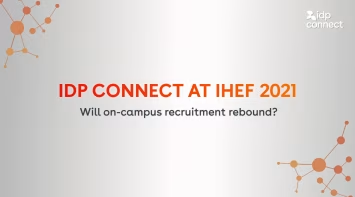Having now emerged out the other side of a very unorthodox Clearing, it seems timely to assess what prospective students’ behaviour looks like for the current recruitment cycle. Taking a dive into our real-time domestic data, which tracks the search behaviours of prospective students across popular student websites: Whatuni and Complete University Guide, from the past 2 months we can glean some insight.
Naturally, due to the tumult of Clearing, the non-typical longevity of post results day activity triggered a shift from the traditional recruitment cycle. Amid the fresh doubt cast over the UK’s recovery from the pandemic and what that may look like, there are substantial question marks around what the current recruitment cycle will resemble.
When are students planning on attending university?

We can see a tidy reduction in the intent for researching students to study in this academic year as September transitions to a close and a consequent increase in 20 21, 2022 and 2023 intakes as October unfolds. While this may seem like relatively pedestrian activity, it’s crucial we look at how these trends compare to last year?

Relative to last year; there is increased intent for the current intake in September, and, interestingly, October saw a marked increase in next year’s intake, with all future intakes being less prominent than the same period last year.
Looking at the data there is strong evidence showing appetite for study in 2021. Given the imminent uncertainty we face as a society, the spike in research for next year’s intake becomes understandable given students are likely picking up in-cycle research later than usual.
What are students’ levels of grade attainment?

For the above graph, universities have been separated into quintiles based on their Complete University Guide league table ranking. The first consisting of the highest ranked, and the fifth the lowest. Looking at activity from 1 September – 31 October we can see the per quintile breakdown by tariff points of researching students.
This is a familiar sight, where the majority of students can be found in the 97-144 tariff point band. Competition for the 145+ tariff band has a tighter stratification, signifying the importance of niche messaging and targeting when it comes to marketing to the higher attaining individual.

120 to 168 tariff band students are the most numerous with September versus October intakes on the rise, demonstrating the transition from Clearing to main cycle and alluding to the previously established correlation between earlier researching and higher attainment.
What are students looking to study?
Below are the top 5 subjects researched in September and October (excluding Clearing).

Social Studies and Business are on the rise, but given the natural fluctuation of subject trends throughout this period of the cycle, the meaningful insights are often unearthed when we start to introduce and combine different data points and look to more granular detail.

So, when we look at the shift in intended year of entry for students researching medicine, we see the typical decline of the current intake as we approach October, and the inverse increase in research for 2021 and beyond.
Notably, the share of this cohort looking at the 2022 intake is almost double the share we see across all subjects, indicating a much earlier research journey than most other subjects starting 24 months in advance of intake.
The below graph shows the top sub-discipline areas performed year on year. With all disciplines demonstrating an excellent amount of growth versus the same period last year. Perhaps an optimistic endorsement of human kindness and compassion with increased interest for disciplines such as Psychology, Crisis Support and Nursing, given the current circumstances we find ourselves in.

It will be an important time for recruitment for most institutions, given the financially trying times encountered this year. However, there is still a long way to go, and a lot more could change. While the past two months have shown a divergence from last year’s cycle, we can only gauge where we are headed with responsive, up-to-date data.
Each institution with its individual brand and position in the market, will be experiencing this cycle differently. Which is why implementing data-led segmentation of advertising and messaging in conjunction with refined levels of targeting is so important. Real-time data, like the above, is critical for institutions in making informed and educated decisions throughout the cycle, fine-tuning current marketing campaigns, informing new strategies and developing new courses.
Find out more about our IQ services, which enable real-time demand analysis, informed trend predictions and far-sighted recruitment strategies to drive conversion and deliver effective ROI outcomes for HE institutions. More information here. Reach out to us on ukclientpartnerships@idp-connect.co.uk
You might like...

International Students Open to New Opportunities Amid Global Policy Changes
Findings from IDP's Voice of the International Student Pulse Survey

5 Things We Learnt from the IEAA National Symposium 2024 | Diversification
Here’s a quick-fire rundown of the most enlightening and surprising talking points from this year’s event.

Day in the Life of IDP Education's CEO
IDP Education CEO and Managing Director, Tennealle O'Shannessy gives us a closer look at her leading role



